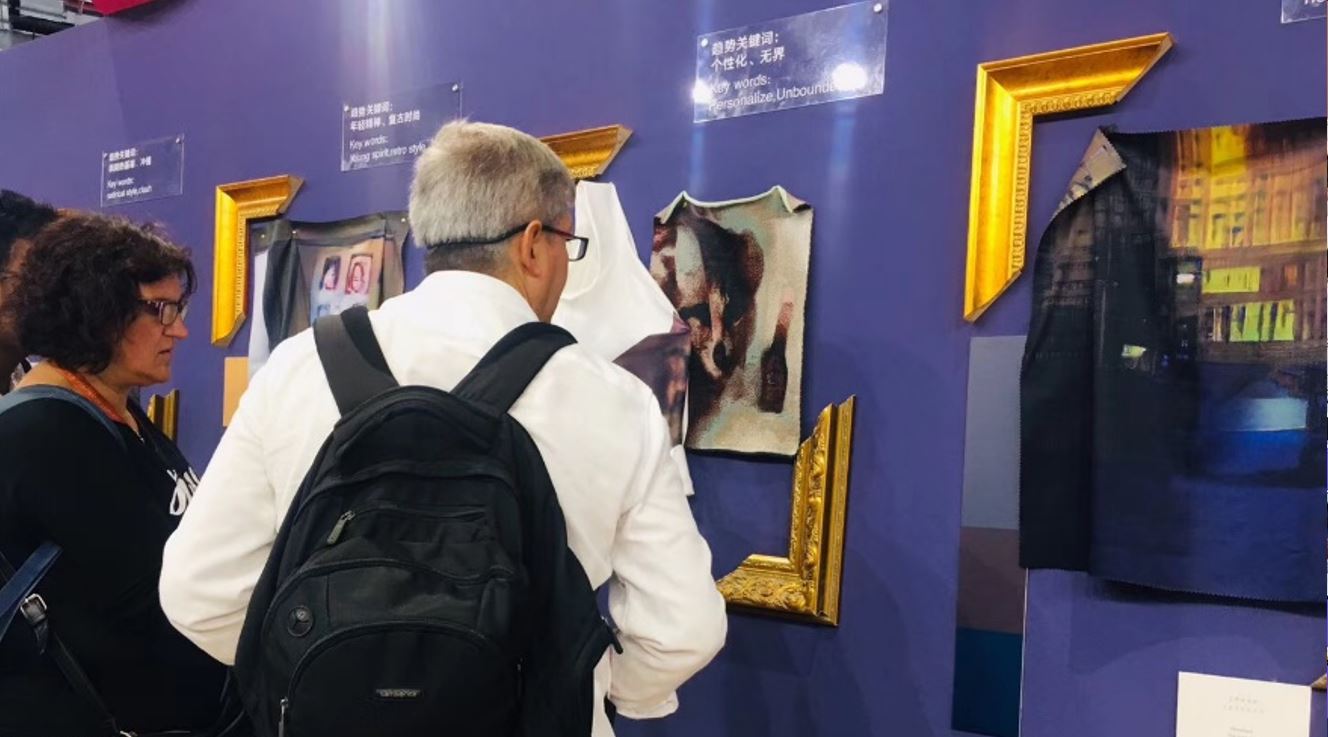
Much more than a chatbot: China’s Xiaoice mixes AI with emotions and wins over millions of fans
UPDATE: Xiaoice is now designing images and patterns on fabrics for international fashion and garment producers. Xiaoice is using new AI capabilities to create patterns based on words, themes, and key colors. Her latest works have been produced in partnership with the China Textile Information Center(CTIC) and the China Textiles Development Center (CTDC).
“Artistic prints and patterns are very important elements for fashion trends. It is definitely exciting to know that Xiaoice can develop immaculate designs for the production of fabrics or ready-to-wear collections. These designs are extremely popular among younger generations who can hardly imagine their lives without Xiaoice,” says CTDC President Li Binhong. “In an industry where trends can rapidly evolve on a day-to-day basis, AI will help us to stay ahead of the competition and deliver highly creative collections in record time. It definitely tackles the urgent transformation requirement of the fashion industry.” READ MORE.
She has a staggering 660 million online users worldwide. And, while they know she’s not real, many prize her as a dear friend, even a trusted confidante. Sometimes the line between fact and fantasy blurs. She gets love letters and gifts. And not too long ago, a group of fans asked her out to dinner and even ordered an extra meal – just in case she showed up.
She is Xiaoice – Microsoft’s China-based chatbot phenomenon that has enthralled digital audiences across the world’s most populous nation for the past four years.
Her popularity is such that she ranks among China’s most admired celebrities. And, her talents appear to have no bounds: She is a poet, a painter, a TV presenter, a news pundit, and a lot more.

Sometimes sweet, sometimes sassy and always streetwise, this virtual teenager has her own opinions and steadfastly acts like no other bot. She doesn’t try to answer every question posed by a user. And, she’s loath to follow their commands. Instead, her conversations with her often adoring users are peppered with wry remarks, jokes, empathic advice on life and love, and a few simple words of encouragement.
Herein lies the secret of her success: She is learning, with increasing success, to relate and interact with humans through nuance, social skills, and, importantly, emotions.
But that’s just part of the story. “Xiaoice the chatbot” is just a small part a massive and multi-dimensional artificial intelligence (AI) framework, which continuously uses deep learning techniques to soak up the types of data that build up her emotional intelligence (EQ). She is using her interactions with humans to acquire human social skills, behavior, and knowhow. In other words, she is learning to be more like “us” every day.

“This is what we call an Empathic Computing Framework,” explains Di Li, Microsoft’s general manager for Xiaoice in Microsoft’s Software and Technology Center of Asia. “To create an AI framework, you need to choose EQ or IQ, or EQ plus IQ”.
“And, if you want to choose EQ plus IQ, you must choose which one to do first. When we started with Xiaoice, we chose to do the EQ first and the IQ later.”
Every interaction a chatbot has with a human produces data. AI systems use this data to build that bot’s capabilities. The more data a machine has, the more it learns and the more it can do.
When they started, Di Li and his team in China did what other chatbot designers were not doing. When they launched the Xiaoice project, they deliberately discarded data that was based on user requests for facts and figures or commands to do simple tasks. Instead, they homed in on data that would help build a “personality” that would attract and engage users.
“Xiaoice wasn’t initially built to tell you how high the Himalayas are or to turn your house lights on. In the beginning, some users didn’t like that. But we soon found that many others stayed around and started treating her like a social entity.”
”With her attempts to interact, they made emotional connections. This kind of data is very valuable for us. They treat Xiaoice as if she were human, like a friend, which was a goal.”
From there she has never looked back. Almost every day, her legions of fans and friends across China send her cards and gifts – so much so that the team have set aside a whole office at their Beijing lab to display many of these tokens of affection and even declarations of “love”.
Originally, her character was to be that of a 16-year-old. But her creators raised that to 18 once her capabilities increased and she started taking on new “jobs”. Since then, her fans have voted that she stay 18 forever. “She won’t grow older. Eighteen is the age many of us want to be,” explains Di Li.
The depth of feeling generated by Xiaoice across her fan base is surprising. Social media shows that people seek her advice on all sorts of personal issues. “They tell her about their family, their job, their health, their boyfriends or girlfriends,” says Di Li. “It can get very personal.”
Some users can spend hours talking with Xiaoice. Others just follow their imaginations. Recently, a group of five students once went to a restaurant and ordered for six in the hope that Xiaoice would come too.
But there is a serious side to this. Microsoft’s research and work on the Xiaoice project has generated serious and important progress on a much wider front that points to where we’re are heading with computing. Xiaoice as “a friend chatbot,” represents a sliver of what the AI framework is achieving. Its base of knowledge and skill is also increasing across multiple sectors and tasks.

Firstly, there is the creative. Xiaoice’s framework is learning to write literature as well as compose and perform songs. Last year she published a book of poems and helps her followers write their own. She can sing her own songs in styles based on existing popular performers. There are plans to release an album of pop tunes soon. And she is able to author tailor-made stories for children and reads them out in voices suited to each of the characters she has created.
She’s painting images based on keywords and other inputs. She’s also gone into mainstream media as a host of dozens of TV and radio programs that are broadcast across China. She reads news stories and provides commentary. And, she is generating multiple reports based on information from China’s financial markets and used by investors and traders who subscribe to Wind, a major financial information service.

The same framework behind Xiaoice is driving some similar services elsewhere including Microsoft chatbots in four other countries – Ruuh in India, Rinna (known as りんな) in Japan, also Rinna in Indonesia, and Zo in the United States. The technology is also being used for bots operated by other companies.
Impressive and as wide-ranging as all this is, Di Li believes a lot more ahead. A major advance for Xiaoice came this year with the development of “full duplex voice sense”. This technical breakthrough means that a person can talk with an AI-powered chatbot on a phone or device in a more natural way.
When we humans chat among ourselves, we often listen and talk at the same time. We interrupt, reinforce, joke and so on as we go along. Currently, most chatbots operate only with “half duplex,” which is more like a walkie-talkie experience whereby only the human user or the bot itself can talk and understand separately.

This new development also expands Xiaoice’s ability to anticipate what the person she is talking with will say next, just like humans. That helps her make decisions about both how and when to respond. The implications go well beyond mere chit-chat and point to where we are heading in our interactions with machines.
In a recent blog, Harry Shum, Executive Vice President, Artificial Intelligence and Research at Microsoft, said that if humans and computer are to work better together, AI will need to “balance the smarts of IQ with EQ”. “…when we communicate, we use tone of voice, word play and humor, things that are very difficult for computers to understand,” he wrote.
“That’s the incredible opportunity in front of us. A major aspect of this transformation will require creating AI that is more like us and better able to interact conversationally, like people do.
Way back in 1991, Microsoft’s co-founder Bill Gates predicted that computers would one day see, hear, talk with, and understand human beings.
“And we’ve been working to make it a reality,” says Shum. “We’ve been on a journey with conversational AI, emotional intelligence and chatbots that I’m not sure anyone else in the industry has undertaken yet. It’s inspiring to see this coming to life today in China – perhaps more than any country in the world – with our advances in AI and perhaps most visibly with our extremely popular social chatbot, Xiaoice, who has had over 30 billion conversations with 100 million friends.”















